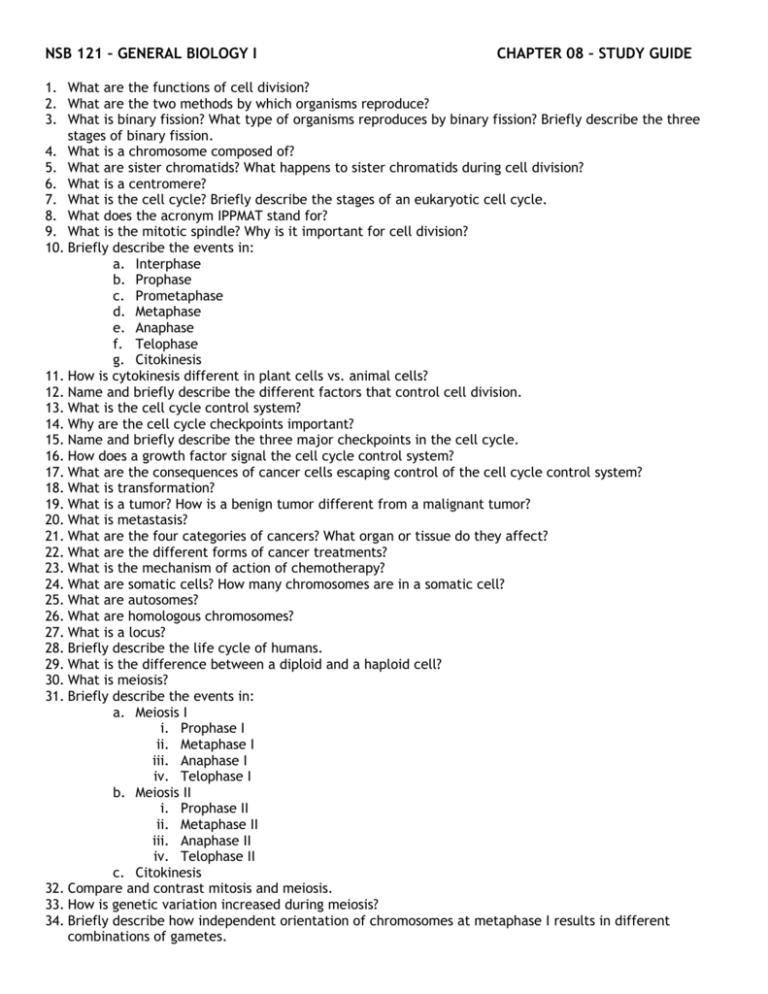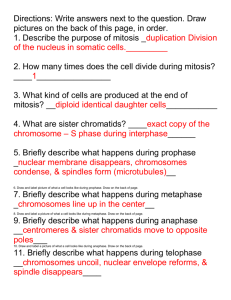Study guide Ch08
advertisement

NSB 121 – GENERAL BIOLOGY I CHAPTER 08 – STUDY GUIDE 1. What are the functions of cell division? 2. What are the two methods by which organisms reproduce? 3. What is binary fission? What type of organisms reproduces by binary fission? Briefly describe the three stages of binary fission. 4. What is a chromosome composed of? 5. What are sister chromatids? What happens to sister chromatids during cell division? 6. What is a centromere? 7. What is the cell cycle? Briefly describe the stages of an eukaryotic cell cycle. 8. What does the acronym IPPMAT stand for? 9. What is the mitotic spindle? Why is it important for cell division? 10. Briefly describe the events in: a. Interphase b. Prophase c. Prometaphase d. Metaphase e. Anaphase f. Telophase g. Citokinesis 11. How is cytokinesis different in plant cells vs. animal cells? 12. Name and briefly describe the different factors that control cell division. 13. What is the cell cycle control system? 14. Why are the cell cycle checkpoints important? 15. Name and briefly describe the three major checkpoints in the cell cycle. 16. How does a growth factor signal the cell cycle control system? 17. What are the consequences of cancer cells escaping control of the cell cycle control system? 18. What is transformation? 19. What is a tumor? How is a benign tumor different from a malignant tumor? 20. What is metastasis? 21. What are the four categories of cancers? What organ or tissue do they affect? 22. What are the different forms of cancer treatments? 23. What is the mechanism of action of chemotherapy? 24. What are somatic cells? How many chromosomes are in a somatic cell? 25. What are autosomes? 26. What are homologous chromosomes? 27. What is a locus? 28. Briefly describe the life cycle of humans. 29. What is the difference between a diploid and a haploid cell? 30. What is meiosis? 31. Briefly describe the events in: a. Meiosis I i. Prophase I ii. Metaphase I iii. Anaphase I iv. Telophase I b. Meiosis II i. Prophase II ii. Metaphase II iii. Anaphase II iv. Telophase II c. Citokinesis 32. Compare and contrast mitosis and meiosis. 33. How is genetic variation increased during meiosis? 34. Briefly describe how independent orientation of chromosomes at metaphase I results in different combinations of gametes. 35. What is random fertilization? 36. What is crossing-over? Briefly describe the events in chromosomes crossing over. 37. What is a karyotype? Why are they useful? 38. Briefly describe how a karyotype is produced. 39. What is the consequence of having an abnormal number of chromosomes? 40. What is the cause of the Down syndrome? 41. How is the age of the mother related to the incidence of Down syndrome in her offspring? 42. What is nondisjunction? What is the consequence of nondisjunction? 43. Briefly describe the two ways in which nondisjunction can take place. 44. Briefly describe the most common human sex chromosome abnormalities. 45. What is a polyploid species? In what organisms can this be found? 46. What are the possible consequences of chromosome breakage? 47. What is the cause of chronic myelogenous leukemia?







